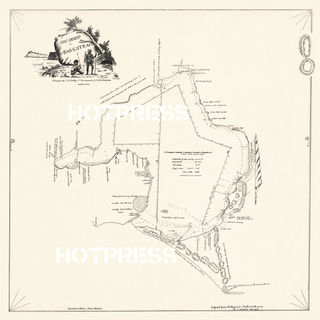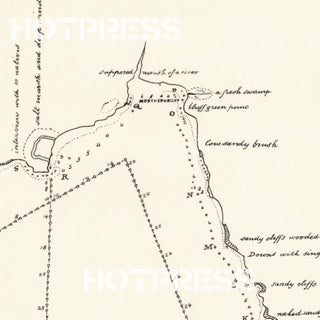1803 Port Phillip Survey Map - Lt. Tuckey
Description
PLEASE NOTE: This is a square print, and the dimensions of this print may require special framing. The sizes that we offer are suitable for a range of IKEA frames.
Captain David Collins had been dispatched from England on the 27th April 1803 to form a penal settlement in Port Phillip Bay.
The party of over 400 people (299 of whom were convicts) settled near present-day Sorrento in October 1803, unfortunately without the report and survey map created by Charles Grimes, which showed where there was abundant fresh water. Collins chose that particular location in order to keep watch for the enemy French ships that might also enter the Bay. However, at that location they found the soil too poor for crops and no fresh water.
Shortly after the camp was set, Lieutenant Tuckey took a survey party in a six-man boat to inspect the area around Port Phillip Bay. At most locations along the shore they experienced aggression from the natives, and returned after one week of surveying. The chart from that excursion is attached.
Collins was never really committed to settling in Port Phillip Bay (as he preferred the area around Hobart in Tasmania), and the Sorrento settlement was abandoned after a few months on 31st January 1804, and Collins and his party relocated to Van Diemen's Land where they established Hobart Town in February 1804.
Matthew Flinders had previously surveyed Port Phillip Bay in 1802, but did not encounter the Yarra. However, he included features from the 1803 Grimes chart and acknowledged the work of Grimes when finalising his maps later for publication (the Matthew Flinders 1802 map is available on this page). The Grimes 1803 map is available on this page.
All text © HotPress
This is a digitally retouched reproduction of the original held by the State Library of Victoria. All prints are reproduced without the HOTPRESS watermarks.
Our team of conservators have worked on a high resolution digital image in order to remove blemishes and artifacts such as stains, mould, scratches and damage caused by the handling of the original. We strive to provide authentic representations of the original work that are suitable for enlargements that retain the tones and character of the original.
Description
PLEASE NOTE: This is a square print, and the dimensions of this print may require special framing. The sizes that we offer are suitable for a range of IKEA frames.
Captain David Collins had been dispatched from England on the 27th April 1803 to form a penal settlement in Port Phillip Bay.
The party of over 400 people (299 of whom were convicts) settled near present-day Sorrento in October 1803, unfortunately without the report and survey map created by Charles Grimes, which showed where there was abundant fresh water. Collins chose that particular location in order to keep watch for the enemy French ships that might also enter the Bay. However, at that location they found the soil too poor for crops and no fresh water.
Shortly after the camp was set, Lieutenant Tuckey took a survey party in a six-man boat to inspect the area around Port Phillip Bay. At most locations along the shore they experienced aggression from the natives, and returned after one week of surveying. The chart from that excursion is attached.
Collins was never really committed to settling in Port Phillip Bay (as he preferred the area around Hobart in Tasmania), and the Sorrento settlement was abandoned after a few months on 31st January 1804, and Collins and his party relocated to Van Diemen's Land where they established Hobart Town in February 1804.
Matthew Flinders had previously surveyed Port Phillip Bay in 1802, but did not encounter the Yarra. However, he included features from the 1803 Grimes chart and acknowledged the work of Grimes when finalising his maps later for publication (the Matthew Flinders 1802 map is available on this page). The Grimes 1803 map is available on this page.
All text © HotPress
This is a digitally retouched reproduction of the original held by the State Library of Victoria. All prints are reproduced without the HOTPRESS watermarks.
Our team of conservators have worked on a high resolution digital image in order to remove blemishes and artifacts such as stains, mould, scratches and damage caused by the handling of the original. We strive to provide authentic representations of the original work that are suitable for enlargements that retain the tones and character of the original.



